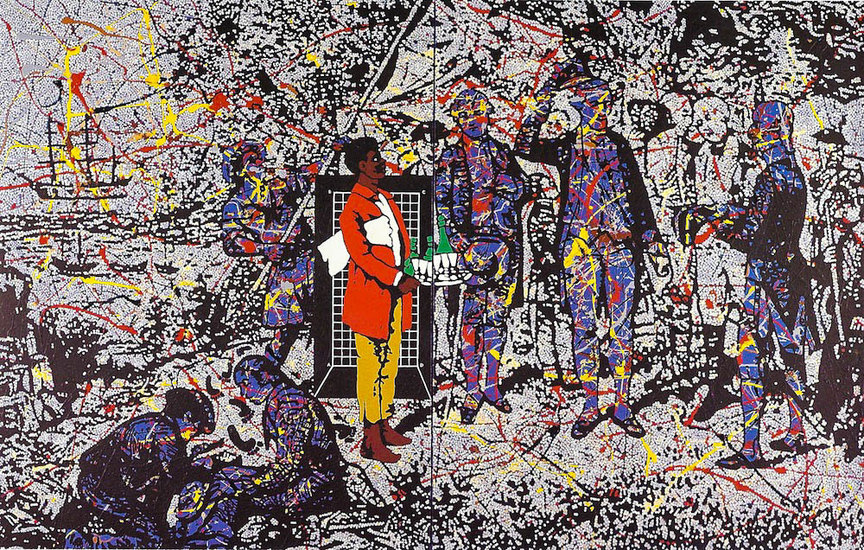Pioneering Australian Artist Gordon Bennett Dies at 58
By Sally Brand

GORDON BENNETT, Possession Island,1991, oil and synthetic polymer paint on canvas,162
Australian artist Gordon Bennett passed away on June 3, 2014, from natural causes at the age of 58. His sudden death came just one week after the opening of the 8th Berlin Biennale, where a series of Bennett’s never-before exhibited drawings from the early 1990s are currently on view. Bennett will be remembered as a hero of Australian art whose practice took aim at race relations, power imbalances, dominant histories and social conventions, producing some of the most iconic images of Australian art history over the past three decades.
Born in 1955 in Monto, in rural Queensland, Bennett spent most of his early life in Victoria in what he described as a “strictly Euro-Australian upbringing and education.” These were not unusual circumstances for an indigenous Australian living under the government’s broad sweeping assimilation policy that attempted to integrate Aboriginal and European cultures by systematically subsuming the former. It was not until he returned to Queensland as a teenager that Bennett first recognized his Aboriginal heritage. In an unpublished text from the late 1980s he recalled entering the work force at the age of 16 where he “really learnt how low the general opinion of Aboriginal people was,” and his response to such prejudice as being, “silence, self-loathing and denial of my heritage.”
In 1986, at the age of 30, after working in various trade jobs for many years, Bennett entered the Queensland College of Art. Three years later, his graduation coincided with the Australian Bicentennial of Britain's First Fleet arriving in Sydney Harbour. It was a fervent time for Aboriginal activists, who instigated fierce public debate concerning Australia’s history—including the vast inequalities experienced by Aboriginal people and the call of Aboriginal land rights. Bennett’s work at the time dealt with Australia’s colonial past using Renaissance perspective grids, dot patterns referencing the mechanical Benday printing process and styles borrowed from Australia’s Central Desert. Stylistic reference was also drawn from artists as wide-ranging as Vincent van Gogh, Clifford Possom Tjapaltjarri, Georg Baselitz, Imants Tillers and Colin McCahon. Charged with energy and emotion, Bennett’s large-scale paintings sought to disrupt the grand narratives of Australia’s colonial history, as well as challenge the country’s political conservatism.
Major institutions immediately recognized the strength of Bennett’s work and in 1989 his paintings were exhibited at both the Museum of Contemporary Art in Sydney and the Art Gallery of New South Wales in the highly regarded survey of contemporary Australian Art “Perspecta 89.” In 1991, Bennett received nationwide exposure when he won the prestigious Moët & Chandon Australian Art Fellowship. He gained further international recognition when he participated in the groundbreaking exhibition “Aratjara: Art of the First Australians” at the Kunstsammlung Nordrhein-Westfalen in Düsseldorf in 1993. In 1995, his work was also exhibited at the John F. Kennedy Center for the Performing Arts, in Washington DC, and at the Guggenheim Museum in New York. In the latter exhibition, Bennett’s Death of the Ahistorical Subject (1993) employed a paint style reminiscent of the drippings of American painter Jackson Pollock combined with sand painting techniques used by the Navajo tribe in the southwestern United States to depict the Australian Aboriginal flag.
In the mid 1990s, Bennett’s practice expanded to incorporate video and performance, ushering in what many critics consider a period of great development for the artist. Shifting from direct appropriation to more sophisticated interpretations of art history, Bennett began making works under the pseudonym John Citizen. His celebrated “Notes to Basquiat” series (1998–2003), inspired by the work of the African-American artist Jean-Michel Basquiat, who shared a similar preoccupation with semiotics and visual language as instruments of marginalization, coupled Australian vernacular language with the raw street style emphasizing, according to the artist, “shared experience as human beings in separate worlds that seek to exclude, objectify and de-humanise the black body and person.”
The 1990s concluded with a major solo exhibition of Bennett’s work at Brisbane City Gallery. “History and Memory in the Art of Gordon Bennett” (1999), curated by Liz Ann MacGregor, subsequently travelled to several venues in Europe, including Ikon Gallery in Birmingham and the Kunstsenter in Oslo. In the early 2000s, Bennett embarked on a series of abstract stripe paintings, which were mutually influenced by American minimalist Frank Stella and the Australian artist Emily Kame Kngwarreye.
In 2007, John Citizen, Bennett’s alter ego was officially recognized in a retrospective at the National Gallery of Victoria in Melbourne. While Bennett vehemently declined to speak about his work in public throughout his life, shrouding his practice in mystery, his images have left an indelible mark on the visual history of Australia, and the world.







